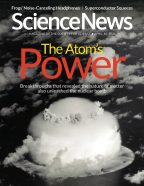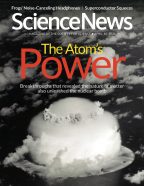
Up in smoke
A band of researchers is studying how microbes carried by wildfire smoke might affect human and ecological health, Megan Sever reported in “Smoke and microbes” (SN: 4/10/21, p. 22).
Sever’s story is “an excellent overview” of pyroaerobiology research, especially that of fire ecologist Leda Kobziar, reader Forrest M. Mims III wrote. Mims’ daughter Sarah discovered that smoke can loft microbes into the air nearly 20 years ago when she was a junior in high school, Mims noted. Using a “50-cent air sampler she flew from a kite and an inexpensive microscope,” she found that smoke from biomass fires in Yucatán, Mexico, had arrived in Texas, carrying bacteria and fungi, he wrote. The father-daughter duo published the results in 2004 in Atmospheric Environment.
“That was a critical pioneering study indeed and is cited in each of my papers,” says Kobziar, of the University of Idaho in Moscow. While Sarah Mims’ study didn’t spark Kobziar’s initial curiosity about pyroaerobiology, Mims’ story should “inspire young scientists to follow their curiosity,” Kobziar says. “It certainly has inspired me!”
Sparks of life
Phosphorus from a lightning-forged version of a mineral called schreibersite could have gone into building the first DNA and RNA molecules on Earth, Maria Temming reported in “Lightning may have sparked life” (SN: 4/10/21, p. 7).
Reader Craig Smith wondered why DNA and RNA would need phosphorus from schreibersite rather than other naturally occurring forms of the element.
“The version of phosphorus that existed in the soil before the lightning struck was not a version that could be used to make biomolecules,” Temming says. Phosphorus in the mineral schreibersite is highly reduced, which means it’s not tightly bound to oxygen in the mineral. That makes this phosphorus easier to extract from the mineral, and thus easier to incorporate into DNA and RNA molecules, than other naturally occurring forms of the element, she says.
Shapeshifter
The weird-looking interstellar object known as ‘Oumuamua may be a piece of nitrogen ice that broke off a Pluto-like exoplanet, Maria Temming reported in “ ‘Oumuamua gets a new origin story” (SN: 4/10/21, p. 6).
Past illustrations of ‘Oumuamua suggested that the object had an elongated shape similar to that of a cigar (SN: 5/9/20 & 5/23/20, p. 12). If the object is made of nitrogen ice, how could it have retained such a shape given the “crushing gravitational forces of its approach to our sun?” reader Bob Reckers asked.
‘Oumuamua is actually now thought to be more pancake-shaped than cigar-shaped (see illustration below). Researchers hypothesize that the object was much thicker when it entered our solar system, Temming says. Proximity to the sun winnowed down ‘Oumuamua, similar to how rubbing a chunky bar of soap gradually wears the bar down to a flat, sharp shard.
If the object is indeed made of nitrogen ice, then it also must be much shinier than scientists originally expected, Temming says. That means ‘Oumuamua must also be slightly smaller than scientists thought to account for the amount of light seen reflecting off it as it whizzed by, she says.


